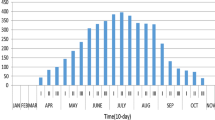Conclusions
-
1.
An increase in the operating efficiency of hydroelectric plants attained by the development and use of additional resources requires the complex examination of a broad range of questions concerning their operating conditions and schedule.
-
2.
For each hydroelectric plant it is necessary to examine all possible means of increasing the efficiency for the entire system of structures and equipment, forcusing attention at hydroelectric plants in mountainous regions on such problems as decreasing seepage losses from the reservoir and intake diversion systems, decreasing head loss and increasing the potential capacity of water-supply conduits and structures, consideration of the variation in the performance curves of units with time, asymmetry of the water supply to turbines in problems dealing with optimum scheduling of power plants operation, particularly for short-term regulation, etc.
-
3.
A distinct power effect may require both optimization of the short-term operating conditions of networks of hydroelectric plants with consideration given to the nonsteady state of the head- and tailwater of the hydraulic facilities and optimum load distribution between electric power plants within the system.
-
4.
The methods for increasing the operating efficiency of hydroelectric plants situated in mountainous regions, which are cited in the present study, can be used at a other hydroelectric plants for similar undertakings under compatible conditions.
Similar content being viewed by others
Literature Cited
T. K. Arshba, “Plotting operating performance curves for high-head hydroelectric plants,” Éxpress-Information Institute of Scientific-Technical Data, “Electrical-Engineering” Series, Tbilisi (1968).
T. K. Arshba, “Optimal redistribution of a given flow between branches with an asymmetric hydraulic scheme employed to supply water to turbines,” Material of the All-Union Conference of Youthful Scientific Workers on Hydraulic Construction, Sukhumi (1969).
D. A. Autse, “Determining the time required to dissipate wave discharges,” in: Problems in Hydraulic Engineering and Hydraulics [in Russian], Urozhai, Kiev (1965).
D. A. Autse, “Power-producing mountain reservoirs in Georgia (basic data, water balance) and the characteristics of their use under regulated conditions,” Theses of Papers Presented at the All-Union Scientific Technical Conference on the Creation and Complex Utilization of Reservoirs, Moscow-Kiev (1965).
D. A. Autse and T. K. Arshba, “Using power-efficiency indicators for regulation to compute optimum short-term operating schedules for hydroelectric plants and networks of hydroelectric stations,” Izv. TNISGÉI (News of the Tbilisi Scientific-Research Institute of Construction and Water-Power Engineering), Vol. 17, Énergiya, Moscow (1967).
D. A. Autse and T. K. Arshba, “Optimizing intraplant conditions at hydroelectric stations with consideration given to turbine wear with time,” TNISGÉI, Vol. 21, Énergiya, Moscow (1971).
D. A. Autse, T. K. Arshba, and R. I. Pataraya, “Effect of short-term regulation of power systems on water conditions of power-producing mountain reservoirs, rivers, and irrigation systems,” in: Problems in Hydraulic Engineering and Hydraulics [in Russian], Urozhai, Kiev (1969).
D. A. Autse and R. I. Pataraya, “Simplified method of covering the load curve of integrated power systems on the basis of the principle of equality of relative increments,” Materials of the Conference on Hydraulic Power Construction and Hydraulic Improvements, Tbilisi (1971).
D. A. Autse and A. I. Kherkheulidze, “Determination of water losses due to seepage from penstocks supplying hydroelectric plants,” Izv. TNISGÉI, Vol. 16, Énergiya, Moscow (1965).
T. G. Gegeliya, “Operating experience gained with certain reservoirs impounding water for hydroelectric plants in Georgia,” Izv. TNISGÉI, Vol. 21, Énergiya, Moscow (1971).
B. I. Kikodze and D. A. Autse, “Results of study of the operating conditions of power-producing mountain reservoirs,” Izv. TNISGÉI, Vol. 11, Gosénergoizdat (1958).
R. I. Pataraya, “Approximate method of compuring nonsteady phenomena in the head and tailwaters of hydraulic facilities subjected to daily regulation,” Proceedings of the Tbilisi Scientific-Research Institute of Construction and Water-Power Engineering, No. 3, Tbilisi (1972).
Additional information
Translated from Gidrotekhnicheskoe Stroitel’stvo, No. 6, pp. 32–36, June, 1976.
Rights and permissions
About this article
Cite this article
Autse, D.A. Increasing the operating efficiency of hydroelectric plants in mountainous regions. Hydrotechnical Construction 10, 581–587 (1976). https://doi.org/10.1007/BF02399218
Issue Date:
DOI: https://doi.org/10.1007/BF02399218




